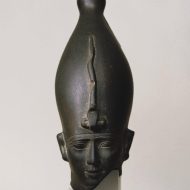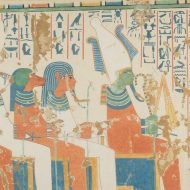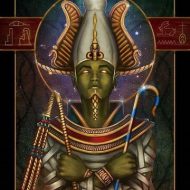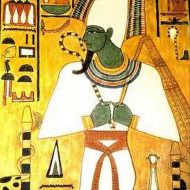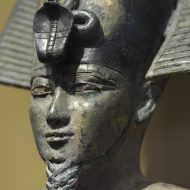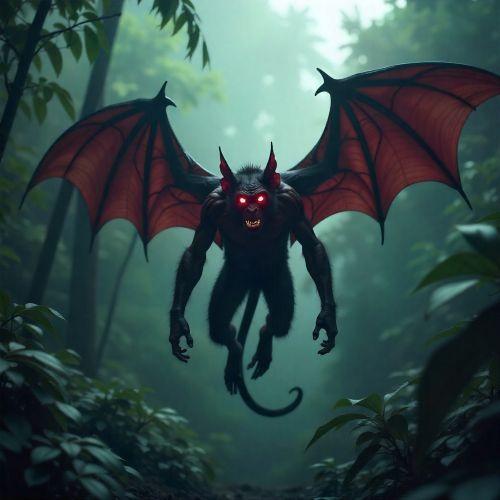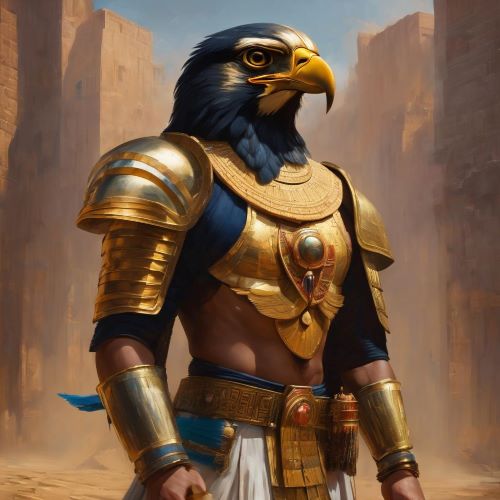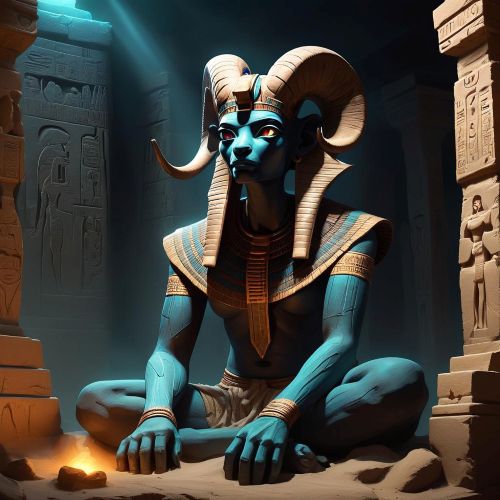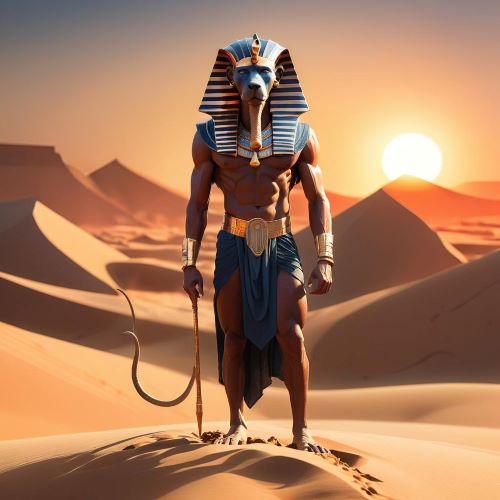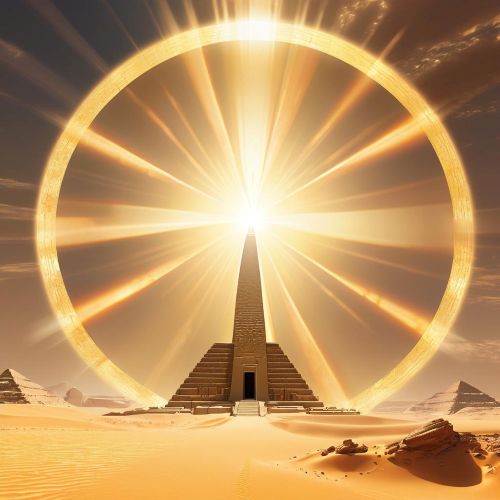Osiris : The Eternal Pharaoh and Egyptian God of Rebirth
Listen
Osiris
Introduction
Osiris stands as one of the most influential and universally recognized deities in ancient Egyptian mythology. Revered as the god of the afterlife, resurrection and fertility, he occupies a vital role in shaping Egyptian spirituality and their enduring belief in life after death. His story of betrayal, sacrifice and triumphant return from the realm of the dead embodies the cycle of decay and renewal central to the Nile civilization. For thousands of years, Egyptians believed that Osiris judged the souls of the deceased and ensured their journey into the eternal paradise of the Field of Reeds. His myth is more than a story; it is the very foundation of Egyptian eschatology and their conviction that death is not an ending, but a transition.
Physical Traits
Osiris is most commonly depicted as a mummified king, symbolizing both the preserved body of the dead and the promise of resurrection. His skin is often colored green or sometimes black, representing vegetation, regeneration and the rich silt that nourished the Nile fields. He frequently wears the Atef crown, a tall white crown flanked by ostrich feathers, marking both his royal authority and his divine rulership over the afterlife. In his hands, crossed over his chest like a pharaoh in burial, he holds the crook and flail, iconic emblems of kingship, protection and agricultural blessing. His posture, wrapped like a mummy yet standing in authority, represents the merging of death and life into one eternal divine state.
Family
Osiris comes from one of the most powerful and enduring divine families in ancient Egyptian tradition. He is the son of Geb, the earth god, and Nut, the sky goddess, linking him to both celestial and terrestrial domains. His sibling relationships shape the drama at the heart of his mythology. Isis, his wife and sister, is a goddess of magic and healing whose devotion restores him when he is betrayed and murdered. Set, his brother, becomes his rival and the embodiment of chaos, violence and desert winds. Nephthys, sister to both Isis and Osiris, also plays a role, offering protection and support during his resurrection. Osiris and Isis’s son Horus inherits the earthly throne and becomes the living embodiment of kingship, while Osiris remains the ruler of the dead. Through this divine lineage, the Egyptian concept of rulership passes from the heavens to the earth and into the afterlife.
Other Names
Osiris was known by many titles that reflect the vast scope of his influence across Egyptian religion. He was often called Asar or Wesir in earlier forms of the language. He was known as “The Lord of Djedu,” referencing the city where his sacred pillar was worshipped, and “Un-nefer,” meaning the perfect or beautiful one. He was also addressed as “King of the Living,” a paradoxical title that emphasized his rule over those who continued existence in the afterlife. These names demonstrate how Osiris represented more than a deity; he was a universal force governing rebirth, moral order and eternal continuity.
Powers and Abilities
Osiris’s central power is his ability to conquer death and grant resurrection. His murder by Set and subsequent restoration by Isis became a powerful symbol of hope and spiritual transformation that defined Egyptian funerary beliefs. As the judge of souls in the Hall of Ma’at, he weighs the moral worth of each person’s life, ensuring that only the righteous enter the blessed afterlife. His connection to the annual flooding of the Nile emphasizes his role in agricultural renewal, sustaining the prosperity and survival of Egypt. Osiris embodies the triumph of order over chaos, faith over despair and life over death. His eternal kingship underscores the idea that rightful rule persists even when physical existence ends, a concept mirrored in the divine mandate of Egypt’s pharaohs, seen as living Horus who would become Osiris at death.
Modern Day Influence
Osiris’s legacy continues to shape global culture, religion and imagination. Within modern spiritual and occult traditions, he symbolizes transformation, ancestry and the hidden mysteries of the soul. His story influences literature, art and cinematic portrayals of gods who die and rise again. Scholars often compare Osiris to other resurrected figures found in world mythology, highlighting his archetypal position in humanity’s understanding of death and renewal. Museums around the world preserve statues, papyri, tomb inscriptions and coffins bearing Osirian symbolism, keeping his story alive for new generations. His myth remains an essential reference in discussions of ancient Egyptian civilization, ethical philosophy and the continuity of spiritual life beyond the grave. Osiris stands today not as a relic of the past but as an ever-living symbol of hope, moral justice and the enduring cycle that binds earth to eternity.
Related Images
Source
Assmann, J. (2001). The search for God in ancient Egypt. Cornell University Press.
Bleeker, C. J. (1967). Isis and Osiris: The divine lovers. Brill.
Hart, G. (2005). The Routledge dictionary of Egyptian gods and goddesses. Routledge.
Lichtheim, M. (1976). Ancient Egyptian literature: Volume II. University of California Press.
Pinch, G. (2004). Egyptian mythology: A guide to the gods, goddesses, and traditions of ancient Egypt. Oxford University Press.
Shaw, I., & Nicholson, P. (2008). The British Museum dictionary of ancient Egypt. The British Museum Press.
Wikipedia Contributors. (2025). Osiris. Wikipedia, The Free Encyclopedia. https://en.wikipedia.org/wiki/Osiris
University College London. Digital Egypt for Universities: Osiris. https://www.ucl.ac.uk/museums-static/digitalegypt/.
Mark, Joshua J. “Osiris: Egyptian God of the Underworld.” World History Encyclopedia, 2016. https://www.worldhistory.org/Osiris/
Lesko, Leonard H. “Death and the Afterlife in Ancient Egyptian Thought.” Journal of Near Eastern Studies, vol. 35, no. 4, 1976, pp. 275–286.
Teeter, Emily. “The Cult of Osiris in Ancient Egypt.” Bulletin of the Oriental Institute, 1995.
Budge, E.A. Wallis. Osiris and the Egyptian Resurrection. Dover Publications, 1973.
Frequently Asked Questions
What is Osiris the god of?
Osiris, the iconic Egyptian deity, wears many crowns. Lord of the Underworld: He reigns over the realm of the dead, judging souls and offering rebirth. His death and resurrection mirror the Nile’s cycle, symbolizing life’s renewal. As a wise ruler, he taught Egyptians farming and embodied ideal kingship. His complex myth, involving murder, magic, and resurrection, resonated deeply with the Egyptians, making him a central figure in their beliefs and art.
Is Osiris good or bad?
Not good nor bad, Osiris weaves life, death, and kingship, a god of both sunlit fields and shadowed tombs.
Who killed Osiris?
In the gripping myth of Osiris, his demise comes at the hands of his own brother, the envious god Seth. Through cunning deception and brutal force, Seth traps Osiris and dismembers him, scattering his pieces across the land. But the story doesn’t end there – the goddess Isis, Osiris’s devoted wife, embarks on a legendary quest to gather the fragments and resurrect her beloved husband.
Who was Osiris in the Bible?
The Bible doesn’t directly mention Osiris, as he belongs to Egyptian mythology predating Judeo-Christian traditions. Some fringe interpretations propose parallels, but these aren’t widely accepted among mainstream theology.
Who is Osiris in love with?
His one true love, his sister-wife: the magical and devoted goddess, Isis.


